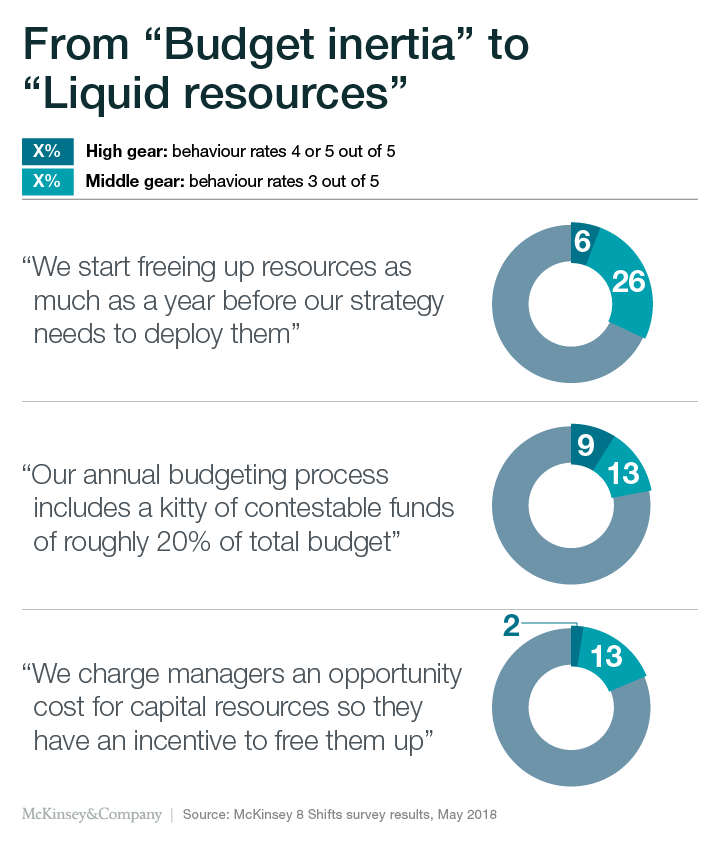It’s budget time again. You want to make a big strategic move that will give your business a strong chance of outperforming the market. You’ve checked the benchmarks and calculated that you need to allocate 15% of all capital and operating expenses across your businesses to new growth opportunities. You have a plan.
But when it’s time to review progress, you find that nothing much has happened. Why? Well, it turns out you don’t have those resources available. You can’t just pull 10% to 20% of the operating budget out of a fully running business without warning.
To mobilize resources necessary to capitalize on opportunities, a company needs a certain level of resource liquidity. That liquidity is the currency of strategy: the prerequisite for making big strategic bets.
Making those resources available represents the handover from strategy to execution. Managers can then be held accountable, since they no longer have the excuse of resource constraints. Yet achieving this resource liquidity is enormously challenging for most companies. In fact, of the eight shifts my colleagues and I believe can put your strategy into a higher gear, this one seems by far the hardest to make: Only 8% of respondents to a recent survey say their companies have achieved even mid-level success.

I’m sympathetic to the challenge. If there were physical laws in business, one of the strongest would be that all resources dissipate the instant they become available. Nevertheless, there are some proactive steps you can take to marshal what you need for big moves.
Free up resources early
You need to start early—on January 1, or whenever your fiscal year begins. That’s when serious productivity-improvement initiatives should get underway if they are to free up resources in time for the reallocation decisions later in the year. Resources can be made available in other ways, of course, such as divestitures and capital injections. The reason I highlight productivity is because strategic resources are not just about cash. Operating expenses and talent are often equal, if not more important, resources to deploy for big moves.
Then you need determination. Because your R&D team will have the most creative new product ideas as soon as an engineer has time. And your sales force will identify the most attractive new business opportunities as soon as the productivity program has idled some sales reps. Firmly separating the initiatives that free resources from the opportunities to re-invest them is fundamental to any meaningful productivity gains—and to ensuring you have the resources to execute your strategy.
Make an “80%-based” budget
You’ve likely heard of the zero-based budget—the concept that every single dollar should be put in the docks and assigned to initiatives based on their merit. It’s a nice idea, and makes a lot of sense in some situations, but you can’t run an operation one year at a time, and you can’t hire and fire an entire workforce every year. What you can do is force a certain portion of the budget to be contestable every year. I’m suggesting 20%, but in some cases 10% might be more realistic. The point is to regularly force money back into the pot, freeing it for reallocation. Remember: to reallocate, you need to de-allocate.
A related idea is to set high targets for productivity improvements—which are distinct from growth goals—to generate a continual kitty of resources. Rather than just requiring business leaders to deliver their numbers, ask that they free up a certain percentage of resources through productivity gains on the base business as well as continually delivering on new growth initiatives.
Place an opportunity cost on resources
One common problem is that resources are viewed as “free” if they don’t directly apply to a specific budget. For example, in many retail businesses, managers are charged with driving sales and gross margins in their categories, yet the scarce resources needed to deliver those gains—the limited shelf space and costly inventory—are often not measured and managed with the same rigor as conventional financial metrics. As a result, managers don’t want to give up space or cut back on inventory, even though doing so would free up resources for other opportunities.
The fix can be as simple as shifting to ratios (such as sales per square foot and returns on inventory for a retailer) that encourage managers to cut back on lower-value uses for those resources. The point is to constantly associate outputs with the inputs used to create them. In fact, my colleagues and I use economic profit to assess corporate performance in Strategy Beyond the Hockey Stick in good part because it accounts for the capital employed to make earnings. But that doesn’t work in all businesses.
US conglomerate Danaher has turned resource liquidity and reallocation into a science. To avoid budget inertia, senior management spends half its time reviewing and re-cutting the portfolio, much like private-equity firms do. The company even has a name for the approach: the Danaher Business System. Based on the kaizen philosophy of continuous improvement, the system institutionalizes the resource liquidity required to chase the best opportunities at any point in time. The company systematically identifies investment opportunities, makes operational improvements to free up resources, and builds new capabilities in the businesses it acquires. Over the past decade, Danaher has dynamically pursued a range of M&A opportunities, organic investments, and divestments—big moves that have helped the company increase economic profits and total returns to shareholders.
Without continually freeing up resources, strategy is merely a paper exercise, constrained by a limited budget. That doesn’t work in a world where big moves are required to move up the Power Curve of performance. Take a look below at how well other companies are doing at adopting the changes I’ve described. Can you do better?
Sven Smit is a senior partner in our Amsterdam office, leader of our client service globally, and co-author of Strategy Beyond the Hockey Stick with Martin Hirt and Chris Bradley.
This article originally appeared on LinkedIn
